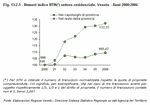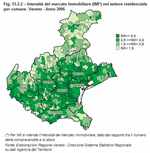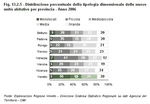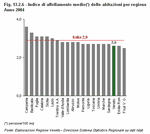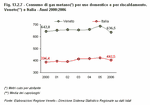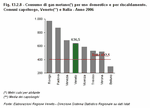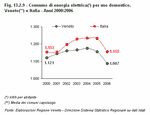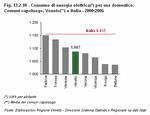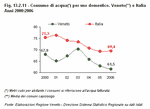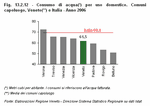|
13.2 - Housing
At the beginning of the chapter we mentioned that housing necessities are one of the reasons people commute and therefore contribute to the increased volume of traffic on the roads. The decision to live in a different area to the place of work is often influenced by family finances and by the trends in the housing market, where prices are often lower on the peripheries than in the main urban centres. Rarely is this decision influenced by a preference for life in the countryside compared to in the city. In recent years there has been a significant increase in the construction of houses, mostly in the provincial municipalities, whilst in the capitals sales and purchases of existing housing have gone up. In the housing sector in 2006, Veneto was in second place out of the Northern regions in terms of trade volumes (NST (Note 1)) and intensity of trade (IHM (Note 2)) of existing stock. From 2000 to 2006, growth in this area was uniform in our region; NST has increased by around 27% since 2000 and has only started to slow down in the last two years. (Table 13.2.1)
The trend in the NST index, which is completely different for the capitals compared to the rest of the province, stands to confirm what has been stated previously, i.e. that the housing market is seeing more and considerable growth in the municipalities in the rest of the province, particularly in the smaller municipalities. (Figure 13.2.1) The map of the IHM indicators per municipality for 2006 also demonstrates that sales and purchases in the municipalities are much more dynamic than in the capitals. (Figure 13.2.2) But what does the region's real estate consist in? In December 2006, according to the urban property register, in Veneto there were 2,362,997 urban housing units (Note 3) (UHU) for ordinary residential use (Note 4) (43% of these were of the "civil dwelling" type and 37% were of the "affordable dwelling" type), making a total of 14,135,385 rooms with a property revenue of 1,219,253,910 euros. These units have an average surface area of 128 m2 and the average surface area of the rooms is 21.6 m2. Twenty percent of these units can be found in the province of Venezia; a further 68% are shared equally amongst Padova, Treviso, Verona and Vicenza; and the remaining 20% are shared between Belluno and Rovigo. (Figure 13.2.3) As far as new buildings (Note 5) (NB) are concerned, 31,337 were registered during 2006, an increase of 1.5% for the whole of Veneto, however if we only take the capital municipalities into consideration, this equals a decrease of 3.3%. Each province showed a different trend: there was more building work done in the Padova area than anywhere else, but the negative values of Rovigo, down 12% (-23% if we look only at the capital), and Verona, down 4% (-36% in the capital) stand out. (Figure 13.2.4) Looking at the new housing units in 2006 in terms of size (Note 6) it can be seen that the most common type is the small dwelling (30%) followed by the medium dwelling (26%). (Figure 13.2.5) Houses in Veneto are the second least crowded in Italy (2.6 people per 100 m2), only just behind Friuli. (Figure 13.2.6) Very few families live in houses without the basic amenities (hot water, indoor toilet, bath or shower, heating). The supply of basic services, i.e. water, gas and electricity, is very good. Only 8.5% of families in Veneto (Italian figure: 13.2%) report having an irregular supply of water. Eighty-three percent of families (Italian figure: 74%) receive gas through a connection to the gas mains, 10% (Italian figure: 19%) buy gas in cylinders, and 6% have a gas cylinder kept outside which is refilled periodically. In households connected to the gas mains, families prove to be satisfied with certain features of the quality of service: 89% expressed overall satisfaction with the service; 93% are satisfied with the safety of the mains network; and 95% with the safety of the household mains. Similar figures can be found as far as satisfaction with the electricity supply is concerned. (Table 13.2.2) Data on gas, electricity and water consumption for domestic use can provide information on the daily habits of the people living in Veneto. In the region, the 2000-2006 figures for average methane gas consumption per capita for domestic use and for heating were rather stable, remaining consistently above the national average and showing marked differences from province to province. (Figure 13.2.7) and (Figure 13.2.8) However, the regional average of electricity consumption for domestic use was lower than the Italian figure for the same period. In 2006 in particular, all of the capital municipalities in Veneto consumed less electricity than on a national level. (Figure 13.2.9) and (Figure 13.2.10) Water consumption was lower than the Italian average and is on the decrease. This is an indication that people in Veneto are using this precious resource carefully and responsibly. (Figure 13.2.11) and (Figure 13.2.12) Energy, its production and its consumption are themes which merit further consideration, both because of energy's vital importance to our daily lives and because, due to the constant increase in demand, the sources of fossil fuels are slowly running out and greenhouse gas emissions are increasing. Experts in the field say that it would be possible to halve the consumption of fossil fuels through the use of technology without compromising on energy supplies: terms such as "energy efficiency" and "energy saving" are used. The latter of these is now considered to be of fundamental importance and the hope is to change people's habits in order to reduce energy consumption. Good results can be achieved simply by adopting certain practices at home, such as buying energy efficient products; regulating the temperature and lighting levels; ensuring the home is fully insulated; and using electrical appliances only at certain times of day. A survey carried out by the Agenzia Regionale per la Prevenzione e Protezione Ambientale del Veneto (Regional Agency for Environmental Protection and Prevention in Veneto) in 2006 as part of the Osservatorio Regionale dei Comportamenti (Regional Behavioural Study) provides some interesting details about Veneto citizens' daily behaviour and its impact on the environment. Fifty-six percent of those interviewed claimed that the level of energy consumption declared on the label by the manufacturer influences their decisions when purchasing and using an electrical appliance, above all because this can lead to savings on electricity bills. Eighty-six percent of those interviewed declared that they often or always turn off the lights when leaving a room. Around half use energy-saving light bulbs. Citizens are also careful about the use of water in order to save on costs: 80% of those interviewed claimed to use water responsibly. Veneto is unusual in that 89% of citizens prefer to drink bottled water rather than tap water; this figure is one of the highest in any of the regions. One last fact regarding the citizens' commitment to behaving responsibly towards the environment: one third of those interviewed found it hardest to cut down on energy consumption, whereas 26% find cutting water consumption the most difficult to do.
|
|
Data elaborated by the Statistics office of the Veneto region are collective property; reproduction of this material is authorised for non-commercial purposes only, provided the source "Regione Veneto - Regional Statistics System Management" is acknowledged.


 Index
Index  Home
Home 
